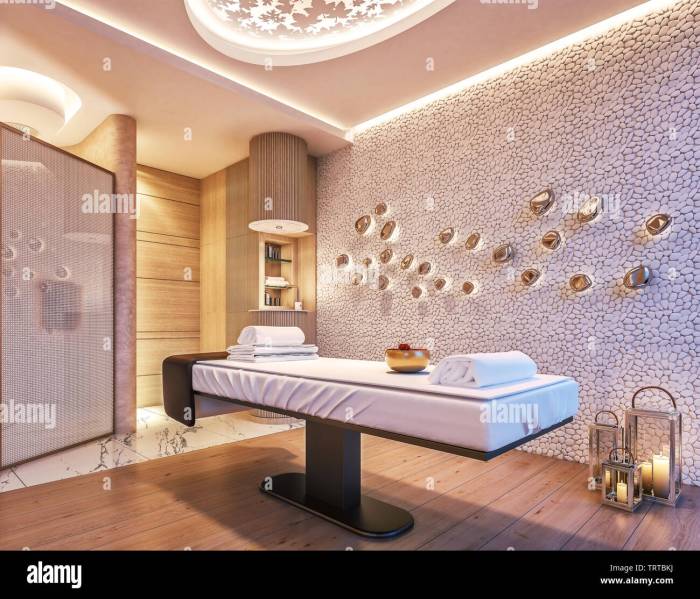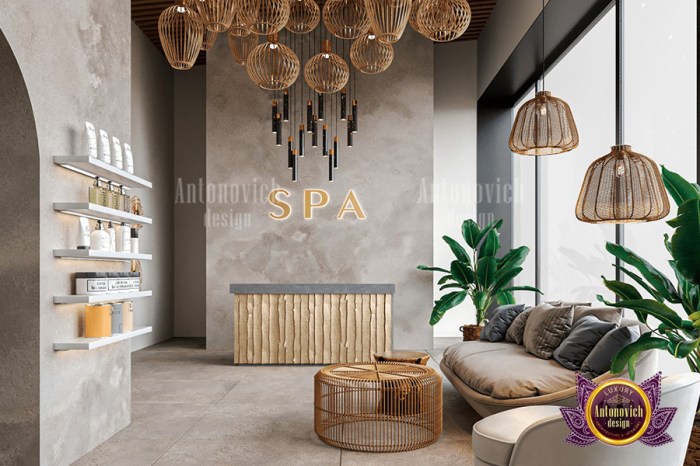Creating a Serene Oasis: Spa Interior Design Essentials
Embark on a journey through the world of spa interior design, where every element is meticulously curated to evoke tranquility and relaxation. From soothing color palettes to the gentle play of lighting, discover how these design choices shape the ultimate spa experience.
Explore the intricate balance between nature-inspired elements, sensory enhancements, and architectural details that come together to create a harmonious sanctuary for the mind, body, and soul.
Importance of Spa Interior Design

Spa interior design plays a crucial role in creating a relaxing and rejuvenating environment for clients. The design elements incorporated in a spa can significantly impact the overall experience and well-being of individuals seeking a retreat from their daily lives.
Role of Colors, Lighting, and Textures in Spa Interior Design
Colors, lighting, and textures are key components of spa interior design that contribute to the ambiance and atmosphere of the space. The careful selection of colors can evoke feelings of calmness, tranquility, and serenity, setting the tone for a peaceful experience.
Soft, natural hues like blues, greens, and earth tones are often used to create a soothing environment.
Proper lighting is essential in a spa setting to create the right mood and enhance the overall experience. Soft, diffused lighting can help to create a warm and inviting atmosphere, while natural light can bring a sense of openness and connection to the outdoors.
Lighting fixtures like dimmers and candles can also add to the ambiance and promote relaxation.
Textures play a significant role in spa interior design by adding depth and tactile appeal to the space. Soft and plush materials like towels, robes, and upholstery can enhance the comfort level for clients, while natural elements like wood, stone, and plants can bring a sense of harmony and balance to the environment.
Elements of Spa Interior Design
Spa interior design is crucial in creating a calming and relaxing atmosphere for guests. The careful selection of furniture, decor, layout, natural elements, scents, and music all play a significant role in enhancing the overall spa experience.
Furniture and Decor
- The choice of furniture should be comfortable, durable, and aesthetically pleasing to create a sense of luxury and relaxation.
- Decor elements such as calming colors, soft textures, and natural materials like wood and stone help to create a serene environment.
- Lighting is also crucial, with soft, warm lighting creating a cozy atmosphere while highlighting key design elements.
Natural Elements: Plants and Water Features
- Plants not only add a touch of nature but also improve air quality and create a sense of tranquility.
- Water features like fountains, indoor waterfalls, or even small ponds can enhance the soothing ambiance and promote relaxation.
- The sound of running water has a calming effect and can drown out external noise, further enhancing the spa experience.
Scents and Music
- Aromatherapy plays a significant role in spa interior design, with carefully selected scents like lavender, eucalyptus, or citrus contributing to a sense of calm and relaxation.
- Soft, soothing music can help create a peaceful ambiance, masking any outside noise and promoting relaxation.
- The combination of pleasant scents and calming music can help guests unwind and de-stress during their spa visit.
Color Schemes and Lighting

When it comes to spa interior design, color schemes and lighting play a crucial role in creating a calming and relaxing atmosphere for clients. The right combination of colors and appropriate lighting can enhance the overall spa experience, promoting a sense of tranquility and well-being.
Popular Color Schemes and Their Psychological Effects
- Soft Neutrals: Shades of beige, cream, and taupe are often used in spa interiors to create a serene and peaceful environment. These colors evoke a sense of relaxation and can help reduce stress and anxiety.
- Cool Blues and Greens: Colors like light blue and sage green are associated with nature and water, promoting a feeling of freshness and rejuvenation. These hues are known to have a calming effect on the mind and body.
- Warm Earth Tones: Colors such as terracotta, rust, and deep browns can create a cozy and grounding atmosphere in a spa. These earthy tones are believed to provide a sense of stability and comfort.
Impact of Lighting Choices on Mood and Atmosphere
- Natural Light: Incorporating natural light into a spa space can help create a sense of openness and connection to the outdoors. Sunlight is known to boost mood and energy levels, enhancing the overall spa experience.
- Soft Lighting: Soft, warm lighting can create a soothing ambiance in a spa, encouraging relaxation and tranquility. Dimmer switches and adjustable lighting fixtures allow for flexibility in setting the desired mood.
- LED Lights: LED lights can be used to create different color temperatures and effects, offering versatility in setting the tone for different treatment areas within the spa. They are energy-efficient and long-lasting, making them a popular choice for spa lighting.
Tips for Selecting the Right Colors and Lighting
- Consider the Overall Theme: Choose colors and lighting that align with the overall theme and concept of the spa, creating a cohesive and harmonious environment.
- Balance Warm and Cool Tones: Combining warm and cool colors can create a sense of balance and harmony in the space, catering to different preferences and enhancing the overall experience.
- Test Different Lighting Options: Experiment with different lighting fixtures and placements to find the right balance between task lighting, ambient lighting, and accent lighting for each area of the spa.
Materials and Textures
Natural materials like wood, stone, and bamboo play a crucial role in creating a serene and calming atmosphere in spa interiors. These elements not only add a touch of nature but also evoke a sense of tranquility and relaxation for guests.
Use of Natural Materials
Using wood in spa interiors can create a warm and inviting ambiance. Whether it's in the form of wooden floors, furniture, or decorative accents, wood adds a natural element that promotes a sense of grounding and connection to nature. Similarly, incorporating stone elements, such as pebble flooring, stone walls, or even a stone basin, can enhance the spa's earthy and organic feel.
Bamboo, known for its sustainable qualities and exotic appeal, can be used for dividers, screens, or even furniture to bring a touch of the orient to the space.
Textures for Depth and Visual Interest
Incorporating different textures in spa design can add depth and visual interest to the space. For example, using rough stone walls in contrast with smooth wooden floors can create a harmonious balance of textures that stimulate the senses. Soft textiles like plush towels, cozy rugs, or silk drapes can also add a luxurious and tactile experience for guests.
Additionally, incorporating elements like water features, such as a bubbling fountain or a cascading waterfall, can introduce dynamic textures that enhance the overall spa experience.
Evoke Tranquility through Materials and Textures
Combining natural materials like wood, stone, and bamboo with a variety of textures can evoke a sense of tranquility in a spa setting. For instance, a combination of warm wooden tones, cool stone textures, and the softness of bamboo can create a harmonious blend that promotes relaxation and rejuvenation.
The interplay of different textures, from rough to smooth, can engage the senses and create a multi-dimensional experience that enhances the overall ambiance of the spa.
Final Thoughts
In conclusion, spa interior design is not just about aesthetics; it's a holistic approach to wellness and rejuvenation. By harmonizing elements like colors, textures, and lighting, a spa can transform into a haven of peace and serenity, offering a retreat from the chaos of everyday life.
Commonly Asked Questions
What role does lighting play in spa interior design?
Lighting choices can significantly impact the mood and atmosphere of a spa, with soft, ambient lighting creating a calming environment for relaxation.
How do natural elements like plants contribute to spa interiors?
Natural elements like plants add a sense of tranquility and freshness to spa spaces, enhancing the overall ambiance and connecting guests with nature.
What are some popular color schemes used in spa interior design?
Popular color schemes include soothing blues and greens, earthy neutrals, and soft pastels, known for their calming and rejuvenating effects.